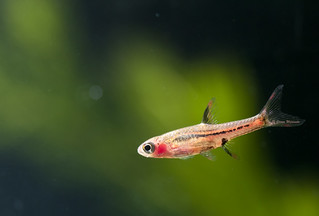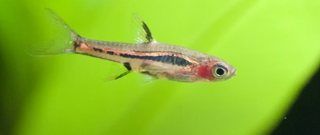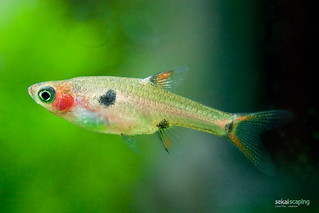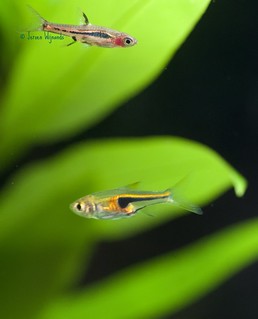Boraras and Trigonostigma in the small shrimp tank
Recently I did a big tank overhaul. Once that had finished and settled I started looking for some new tank mates for my 54 liter tank. It's planted and features an anubias covered piece of wood as it's centerpiece. The tank was inhabited at that time by 3 Boraras brigittae, a lonely golden tetra and a large number of shrimp. It's filtered by the standard juwel filter setup.
I started looking for some more brigittae to bring the school back to a decent size again. Bit of research showed me there's a few species that are largely similar.
Boraras brigittae

Boraras brigittae - Mosquito Rasbora by j_wijnands, on Flickr
Boraras merah

These are Indonesian and largely similar.
A bit further up in south east Asia we find Boraras Maculatus. Some source list this as Mainland only especially the Malay peninsula but other sources claim it's also found in Sumatra.

Boraras maculatus by Chantal Wagner, on Flickr
http://www.fishbase.org/summary/Boraras-maculatus.html
Further to the west still in Thailand and Vietnam there's Boraras urophthalmoides

Boraras urophthalmoides by swordw, on Flickr
Now the latter I've never seen in shops here in the Netherlands but the first three are available but not all that common. These fish are also mislabled extremely often!
All of these species have a few things in common first and most apparant is of course their size. These fish are tiny! A hefty adult female could measure a whopping 22mm, literature lists 25mm as maximum. They're also found in somewhat similar conditions, heavy planted streams in the forest. Lighting is dim and there's loads of leaf litter and other debris on the bottom.
Once my tank stabilised I bought a school of 10 merah because I just could not get any Brigittae within a 50km radius of where I live. Followed the standard introduction technique and to my intense relieve the merah immediately hooked up with the remaining brigittae.
Over the first week I've lost 2 of the 10 to unknown causes. With a good shrimp population dead fish just disappear.
They seemed to do well, the school falling apart in 3 groups when hunting for food but immediately hooking up again if they thought there was any danger. Seeing these little guys drift just below the surface waiting for any insects is great fun, they really seem to think they're jaws!
One of the male merah has developed a strange fixation with the left wall of the tank, it's constantly fighting it's own reflection. Two others have joined up with a brigittae and can often be seen hunting in the dense population on the edges of the tank.
Things really perked up after I introduced a dose of peat to my filter. As the water coloured the fish perked up. They're now displaying full colours all the time, not just at meal times and some are now making overtures to the females of the group.
A happy brigittae especially can be really quite colourful as you can see

Additionally I got 6 rasbora Hengeli or Trigonostigma hengeli as they're known since 1999. Most people will know this as a small fish but compared to the boraras species it's positively huge!
My store had a mix of adult females and somewhat younger males. The smallest of which is here next to a merah

The adult females are almost twice as big.
Hengeli comes also from Indonesia but a bit more towards the eastern islands. Even though they don't seem to mind the difference. It's a more active and noticeable species than their tiny tankmates but they do get along well. Old eeyore the tetra hooked up with them, is happy once again and even had a brief romantic interlude with one of the younger male hengeli
The Hengeli also seem to appreciate the addition of peat, they're now flying full colours almost all the time.
Feeding these is easy, they take the staple of Tetramin flakes easily but I do have to grind half the flakes rather fine between my fingers otherwise it's just too big for the boraras. I've also fed TetraFreshDelica Brine Shrimps. Which they take too when it's moved around by the filter but otherwise don't really care for too much. Pretty soon the weather will heat up here and I will see how they react to fresh mosquito larvae.
All of these are absolutely safe for adult shrimp, apart from an occasional attempt to steal food from a shrimp they leave each other alone. In my opinion the boraras could make a nice addition to a well planted aquascape. Do keep them in groups of at least 8 otherwise they will act skittish.
Recently I did a big tank overhaul. Once that had finished and settled I started looking for some new tank mates for my 54 liter tank. It's planted and features an anubias covered piece of wood as it's centerpiece. The tank was inhabited at that time by 3 Boraras brigittae, a lonely golden tetra and a large number of shrimp. It's filtered by the standard juwel filter setup.
I started looking for some more brigittae to bring the school back to a decent size again. Bit of research showed me there's a few species that are largely similar.
Boraras brigittae

Boraras brigittae - Mosquito Rasbora by j_wijnands, on Flickr
Boraras merah

These are Indonesian and largely similar.
A bit further up in south east Asia we find Boraras Maculatus. Some source list this as Mainland only especially the Malay peninsula but other sources claim it's also found in Sumatra.

Boraras maculatus by Chantal Wagner, on Flickr
http://www.fishbase.org/summary/Boraras-maculatus.html
Further to the west still in Thailand and Vietnam there's Boraras urophthalmoides

Boraras urophthalmoides by swordw, on Flickr
Now the latter I've never seen in shops here in the Netherlands but the first three are available but not all that common. These fish are also mislabled extremely often!
All of these species have a few things in common first and most apparant is of course their size. These fish are tiny! A hefty adult female could measure a whopping 22mm, literature lists 25mm as maximum. They're also found in somewhat similar conditions, heavy planted streams in the forest. Lighting is dim and there's loads of leaf litter and other debris on the bottom.
Once my tank stabilised I bought a school of 10 merah because I just could not get any Brigittae within a 50km radius of where I live. Followed the standard introduction technique and to my intense relieve the merah immediately hooked up with the remaining brigittae.
Over the first week I've lost 2 of the 10 to unknown causes. With a good shrimp population dead fish just disappear.
They seemed to do well, the school falling apart in 3 groups when hunting for food but immediately hooking up again if they thought there was any danger. Seeing these little guys drift just below the surface waiting for any insects is great fun, they really seem to think they're jaws!
One of the male merah has developed a strange fixation with the left wall of the tank, it's constantly fighting it's own reflection. Two others have joined up with a brigittae and can often be seen hunting in the dense population on the edges of the tank.
Things really perked up after I introduced a dose of peat to my filter. As the water coloured the fish perked up. They're now displaying full colours all the time, not just at meal times and some are now making overtures to the females of the group.
A happy brigittae especially can be really quite colourful as you can see

Additionally I got 6 rasbora Hengeli or Trigonostigma hengeli as they're known since 1999. Most people will know this as a small fish but compared to the boraras species it's positively huge!
My store had a mix of adult females and somewhat younger males. The smallest of which is here next to a merah

The adult females are almost twice as big.
Hengeli comes also from Indonesia but a bit more towards the eastern islands. Even though they don't seem to mind the difference. It's a more active and noticeable species than their tiny tankmates but they do get along well. Old eeyore the tetra hooked up with them, is happy once again and even had a brief romantic interlude with one of the younger male hengeli
The Hengeli also seem to appreciate the addition of peat, they're now flying full colours almost all the time.
Feeding these is easy, they take the staple of Tetramin flakes easily but I do have to grind half the flakes rather fine between my fingers otherwise it's just too big for the boraras. I've also fed TetraFreshDelica Brine Shrimps. Which they take too when it's moved around by the filter but otherwise don't really care for too much. Pretty soon the weather will heat up here and I will see how they react to fresh mosquito larvae.
All of these are absolutely safe for adult shrimp, apart from an occasional attempt to steal food from a shrimp they leave each other alone. In my opinion the boraras could make a nice addition to a well planted aquascape. Do keep them in groups of at least 8 otherwise they will act skittish.
No comments:
Post a Comment